Experimental Investigation of Debris-Induced Loading in Tsunami-Like Flood Events
Abstract
:1. Introduction
- Examine the influence of the supplied debris volume on the debris dam formation.
- Determine the influence of debris mixtures, based on the quantity and type of debris supplied, on debris dam formation.
- Evaluate the horizontal in-stream loads caused by the formation of a debris dam at the face of the structure.
- Examine the influence of debris dam properties such as non-structural void fraction and size on loads and backwater rise.
2. Experimental Setup
2.1. Experimental Facilities
2.2. Instrumentation
2.3. Model Debris
2.4. Experimental Protocol
2.5. Debris Dam Measurement
2.6. Statistical Analysis
2.6.1. Paired T-Test
2.6.2. Analysis of Covariance (ANCOVA)
3. Results
3.1. Experimental Hydrodynamics
3.2. Debris Geometry
3.3. Debris Dam Properties
3.4. Backwater Rise
3.5. Drag Forces
4. Discussion
5. Conclusions
- The capture efficiency of the debris was dependent on the physical dimensions (length, width, and height) of the debris relative to the opening width of the obstacle. The larger characteristic length of the debris, the more readily the debris were captured at the obstacle.
- An increase in the supplied volume of debris to the obstacle resulted in an increase in the length, width, and depth of the debris dam.
- Flow velocity had a significant influence on the blockage of the channel. The increased velocity resulted in the debris being pushed towards the bed resulting in an increased depth of the dam. Decreased velocity resulted in the formation of a debris carpet at the free-surface in front of the obstacle.
- Hydrodynamic conditions (initial flow depth and velocity) had a significant influence on the backwater levels. An increase in the Froude number resulted in a larger blockage ratio and a more pronounced backwater rise.
- Hydrodynamic conditions did not have a significant influence on the drag forces acting on the obstacle. The increase in the water depth due to the backwater rise and decrease in flow velocity resulted in no significant increase. However, the restriction of the flow around the obstacle as a result of the two-dimensional (2-D) characteristics of the flow contributed to this result and should therefore be addressed in a 3-D setting.
Acknowledgments
Author Contributions
Conflicts of Interest
References
- Crosset, K.M. Population Trends Along the Coastal United States: 1980–2008; Government Printing Office: Washington, DC, USA, 2005.
- Small, C.; Nicholls, R.J. A global analysis of human settlement in coastal zones. J. Coast. Res. 2003, 19, 584–599. [Google Scholar]
- Mousavi, M.E.; Irish, J.L.; Frey, A.E.; Olivera, F.; Edge, B.L. Global warming and hurricanes: The potential impact of hurricane intensification and sea level rise on coastal flooding. Clim. Chang. 2011, 104, 575–597. [Google Scholar] [CrossRef]
- Cutter, S.L.; Emrich, C.T. Moral hazard, social catastrophe: The changing face of vulnerability along the hurricane coasts. Ann. Am. Acad. Political Soc. Sci. 2006, 604, 102–112. [Google Scholar] [CrossRef]
- Ghobarah, A.; Saatcioglu, M.; Nistor, I. The impact of the 26 December 2004 earthquake and tsunami on structures and infrastructure. Eng. Struct. 2006, 28, 312–326. [Google Scholar] [CrossRef]
- Robertson, I.; Riggs, H.R.; Yim, S.C.; Young, Y.L. Lessons from Hurricane Katrina storm surge on bridges and buildings. J. Waterw. Port Coast. Ocean Eng. 2007, 133, 463–483. [Google Scholar] [CrossRef]
- Naito, C.; Cercone, C.; Riggs, H.R.; Cox, D. Procedure for site assessment of the potential for tsunami debris impact. J. Waterw. Port Coast. Ocean Eng. 2014, 140, 223–232. [Google Scholar] [CrossRef]
- Yeh, H.; Sato, S.; Tajima, Y. The 11 March 2011 East Japan earthquake and tsunami: Tsunami effects on coastal infrastructure and buildings. Pure Appl. Geophys. 2013, 170, 1019–1031. [Google Scholar] [CrossRef]
- Saatcioglu, M.; Ghobarah, A.; Nistor, I. Effects of the December 26, 2004 Sumatra earthquake and tsunami on physical infrastructure. ISET J. Earthq. Technol. 2005, 42, 79–94. [Google Scholar]
- Takagi, H.; Esteban, M.; Shibayama, T.; Mikami, T.; Matsumaru, R.; Nguyen, D.; Oyama, T.; Nakamura, R. Track analysis, simulation and field survey of the 2013 Typhoon Haiyan storm surge. J. Flood Risk Manag. 2014, 10, 1111. [Google Scholar] [CrossRef]
- Aghl, P.; Naito, C.; Riggs, H. Full-scale experimental study of impact demands resulting from high mass, low velocity debris. J. Struct. Eng. 2014, 140, 04014006. [Google Scholar] [CrossRef]
- Haehnel, R.B.; Daly, S.F. Maximum impact force of woody debris on floodplain structures. J. Hydraul. Eng. 2004, 130, 112–120. [Google Scholar] [CrossRef]
- Matsutomi, H. Method for estimating collision force of driftwood accompanying tsunami inundation flow. J. Dis. Res. 2009, 4, 435–440. [Google Scholar] [CrossRef]
- Nouri, Y.; Nistor, I.; Palermo, D.; Cornett, A. Experimental investigation of tsunami impact on free standing structures. Coast. Eng. J. 2010, 52, 43–70. [Google Scholar] [CrossRef]
- Shafiei, S.; Melville, B.W.; Shamseldin, A.Y.; Beskhyroun, S.; Adams, K.N. Measurements of tsunami-borne debris impact on structures using an embedded accelerometer. J. Hydraul. Res. 2016, 54, 1–15. [Google Scholar] [CrossRef]
- Nistor, I.; Goseberg, N.; Stolle, J. Tsunami-Driven Debris Motion and Loads: A Critical Review. Front. Built Environ. 2017, 3, 2. [Google Scholar] [CrossRef]
- Stolle, J.; Nistor, I.; Goseberg, N.; Mikami, T.; Shibayama, T. Entrainment and Transport Dynamics of Shipping Containers in Extreme Hydrodynamic Conditions. Coast. Eng. J. 2017, 1750011. [Google Scholar] [CrossRef]
- Haehnel, R.B.; Daly, S.F. Maximum Impact Force of Woody Debris on Floodplain Structures; USACE: Washington, DC, USA, 2002. [Google Scholar]
- Federal Emergency Management Agency (FEMA). Guidelines for Design of Structure for Vertical Evacuation from Tsunamis; FEMA: Washington, DC, USA, 2012; p. 646.
- Parola, A.C. Debris Forces on Highway Bridges; Transportation Research Board: Washington, DC, USA, 2000. [Google Scholar]
- Schmocker, L.; Hager, W.H. Probability of drift blockage at bridge decks. J. Hydraul. Eng. 2011, 137, 470–479. [Google Scholar] [CrossRef]
- Pagliara, S.; Carnacina, I. Bridge pier flow field in the presence of debris accumulation. In Proceedings of the Institution of Civil Engineers-Water Management; Thomas Telford Ltd.: London, UK, 2013; Volume 166, pp. 187–198. [Google Scholar]
- Melville, B.W.; Dongol, D. Bridge pier scour with debris accumulation. J. Hydraul. Eng. 1992, 118, 1306–1310. [Google Scholar] [CrossRef]
- Fenton, J. The effects of obstacles on surface levels and boundary resistance in open channels. In Proceedings of the 30th IAHR Congress, Thessaloniki, Greece, 24–29 August 2003; Volume 2, pp. 9–16. [Google Scholar]
- Schmocker, L.; Hager, W.H. Scale modeling of wooden debris accumulation at a debris rack. J. Hydraul. Eng. 2013, 139, 827–836. [Google Scholar] [CrossRef]
- Pagliara, S.; Carnacina, I. Temporal scour evolution at bridge piers: Effect of wood debris roughness and porosity. J. Hydraul. Res. 2010, 48, 3–13. [Google Scholar] [CrossRef]
- Stancanelli, L.; Lanzoni, S.; Foti, E. Propagation and deposition of stony debris flows at channel confluences. Water Resour. Res. 2015, 51, 5100–5116. [Google Scholar] [CrossRef]
- Pasha, G.A.; Tanaka, N. Effectiveness of Finite Length Inland Forest in Trapping Tsunami-Borne Wood Debris. J. Earthq. Tsunami 2016, 1650008. [Google Scholar] [CrossRef]
- Bocchiola, D.; Rulli, M.; Rosso, R. A flume experiment on the formation of wood jams in rivers. Water Resour. Res. 2008, 44. [Google Scholar] [CrossRef]
- Chock, G.Y. Design for tsunami loads and effects in the ASCE 7-16 standard. J. Struct. Eng. 2016, 142, 04016093. [Google Scholar] [CrossRef]
- National Building Code of Canada 2005; Canadian Commission on Building and Fire Codes: Ottawa, ON, Canada, 2005.
- Huang, N.E.; Shen, Z.; Long, S.R.; Wu, M.C.; Shih, H.H.; Zheng, Q.; Yen, N.-C.; Tung, C.C.; Liu, H.H. The empirical mode decomposition and the Hilbert spectrum for nonlinear and non-stationary time series analysis. In Proceedings of the Royal Society of London A: Mathematical, Physical and Engineering Sciences; The Royal Society: London, UK, 1998; Volume 454, pp. 903–995. [Google Scholar]
- Knorr, W.; Kutzner, F. EcoTransIT: Ecological Transport Information Tool—Environmental Method and Data; IFEU: Heidelberg, Germany, 2008. [Google Scholar]
- Nistor, I.; Palermo, D. Post-Tsunami Engineering Forensics: Tsunami Impact on Infrastructure. Lessons from 2004 Indian Ocean, 2010 Chile, and 2011 Tohoku Japan Tsunami Field Surveys; Esteban, M., Takagi, H., Shibayama, T., Eds.; Elsevier: Amsterdam, The Netherlands, 2015; pp. 418–434. [Google Scholar]
- Bazant, Z.P. Scaling of Structural Strength; Butterworth-Heinemann: Oxford, UK, 2005. [Google Scholar]
- McDonald, J.H. Handbook of Biological Statistics; Sparky House Publishing: Baltimore, MD, USA, 2009; Volume 2. [Google Scholar]
- Madsen, P.A.; Fuhrman, D.R.; Schaeffer, H.A. On the solitary wave paradigm for tsunamis. J. Geophys. Res. Oceans 2008, 113. [Google Scholar] [CrossRef]
- Mitobe, Y.; Adityawan, M.B.; Roh, M.; Tanaka, H.; Otsushi, K.; Kurosawa, T. Experimental Study on Embankment Reinforcement by Steel Sheet Pile Structure Against Tsunami Overflow. Coast. Eng. J. 2016, 58, 1640018. [Google Scholar] [CrossRef]
- Fritz, H.M.; Borrero, J.C.; Synolakis, C.E.; Yoo, J. 2004 Indian Ocean tsunami flow velocity measurements from survivor videos. Geophys. Res. Lett. 2006, 33. [Google Scholar] [CrossRef]
- Hughes, S.A. Physical Models and Laboratory Techniques in Coastal Engineering; World Scientific: Singapore, 1993; Volume 7. [Google Scholar]
- Bricker, J.D.; Gibson, S.; Takagi, H.; Imamura, F. On the need for larger Manning’s roughness coefficients in depth-integrated tsunami inundation models. Coast. Eng. J. 2015, 57, 1550005. [Google Scholar] [CrossRef]
- Rueben, M.; Cox, D.; Holman, R.; Shin, S.; Stanley, J. Optical Measurements of Tsunami Inundation and Debris Movement in a Large-Scale Wave Basin. J. Waterw. Port Coast. Ocean Eng. 2014, 141, 04014029. [Google Scholar] [CrossRef]
- El-Alfy, K. Backwater rise due to flow constriction by bridge piers. Thirteen. Int. Water Technol. Converence 2009, 13, 1295–1313. [Google Scholar]
- CSA. Canadian Highway Bridge Design Code; CSA: Santa Cruz, CA, USA, 2006. [Google Scholar]
- AASHTO. Bridge Design Specifications; AASHTO: Washington, DC, USA, 2012. [Google Scholar]
- Yunus, A.C.; Cimbala, J.M. Fluid mechanics fundamentals and applications. McGraw-Hill Publ. 2006, 2, 136–138. [Google Scholar]
- Anthoine, J.; Olivari, D.; Portugaels, D. Wind-tunnel blockage effect on drag coefficient of circular cylinders. Wind Struct. 2009, 12, 541–551. [Google Scholar] [CrossRef]
- Granville, P.S. Elements of the Drag of Underwater Bodies; DTIC Document; DTIC: Fort Belvoir, VA, USA, 1976. [Google Scholar]
- Stevens, B.L.; Lewis, F.L.; Johnson, E.N. Aircraft Control and Simulation: Dynamics, Controls Design, and Autonomous Systems; John Wiley & Sons: Hoboken, NJ, USA, 2015. [Google Scholar]
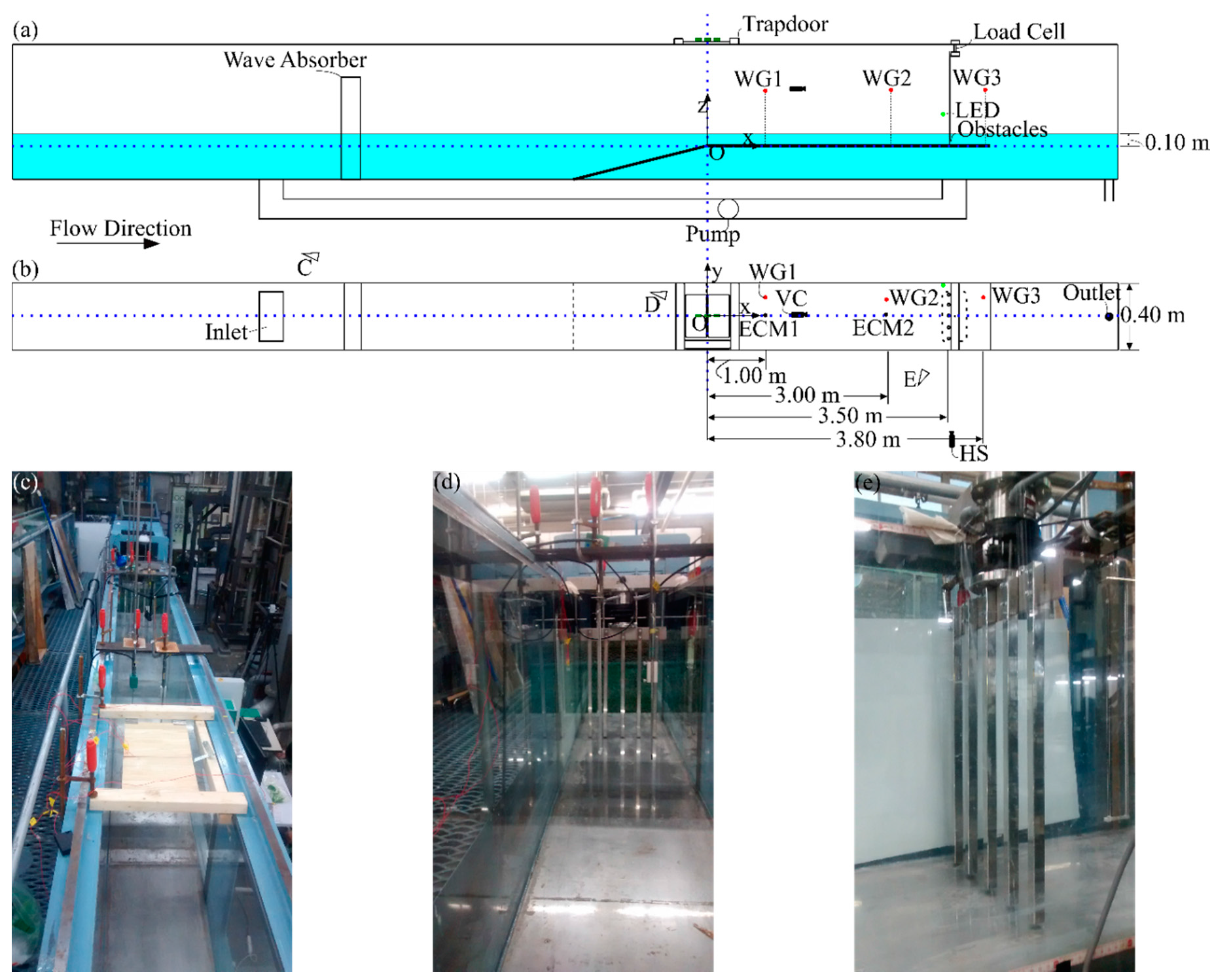
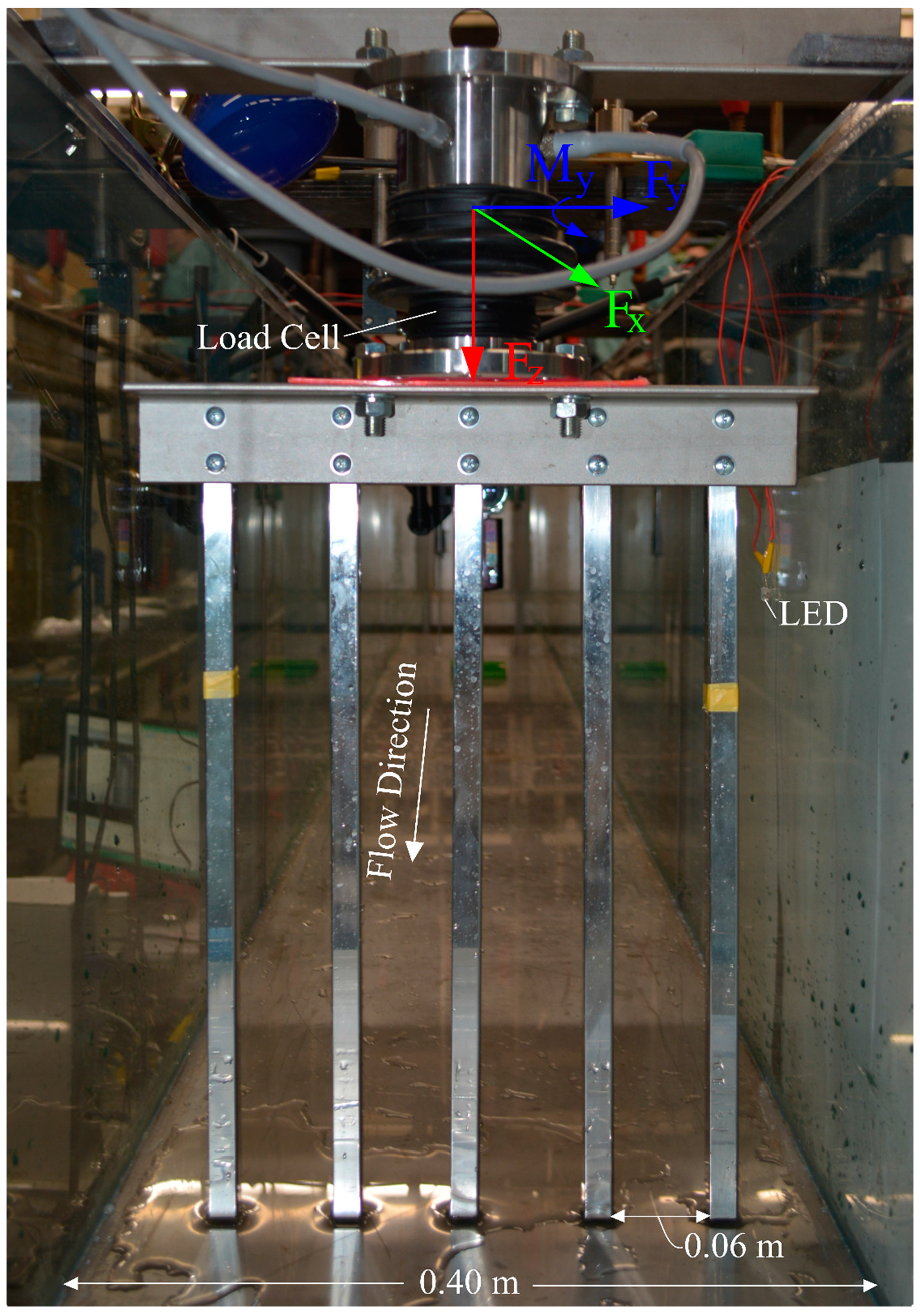
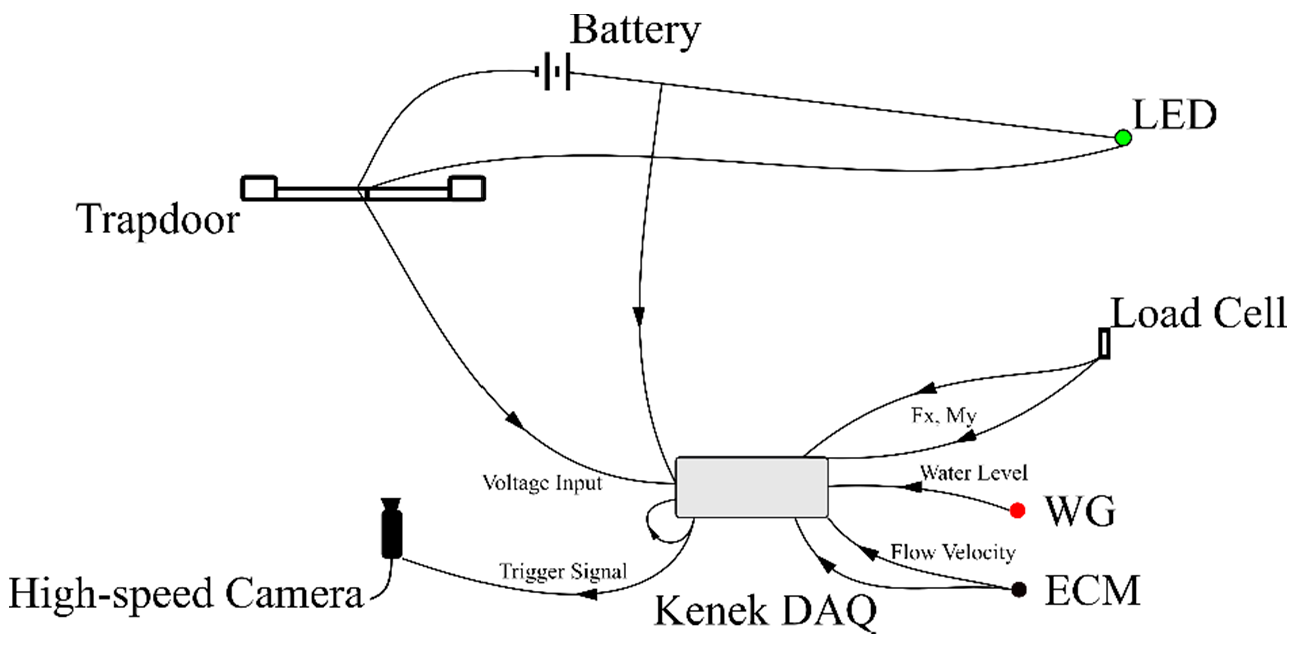
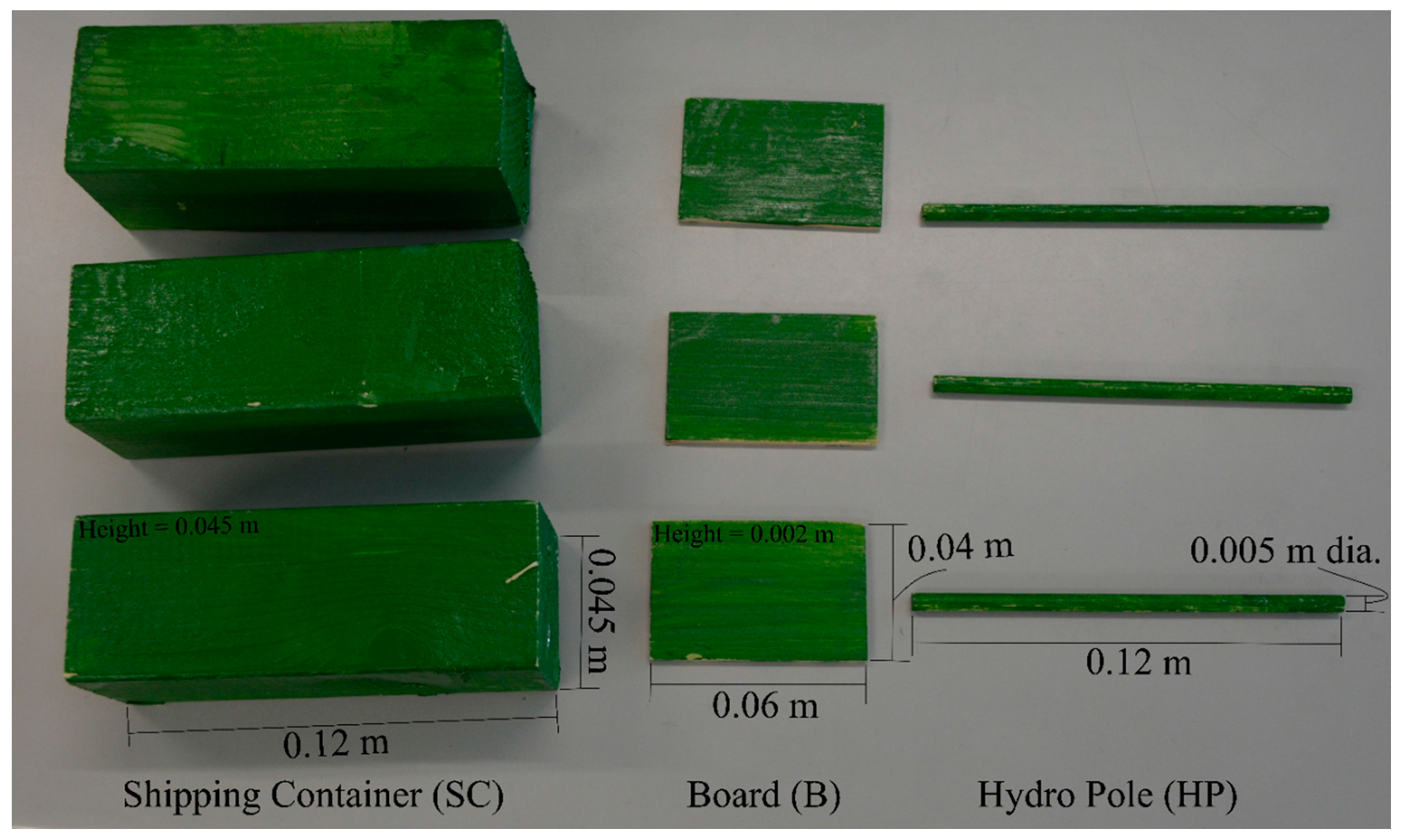


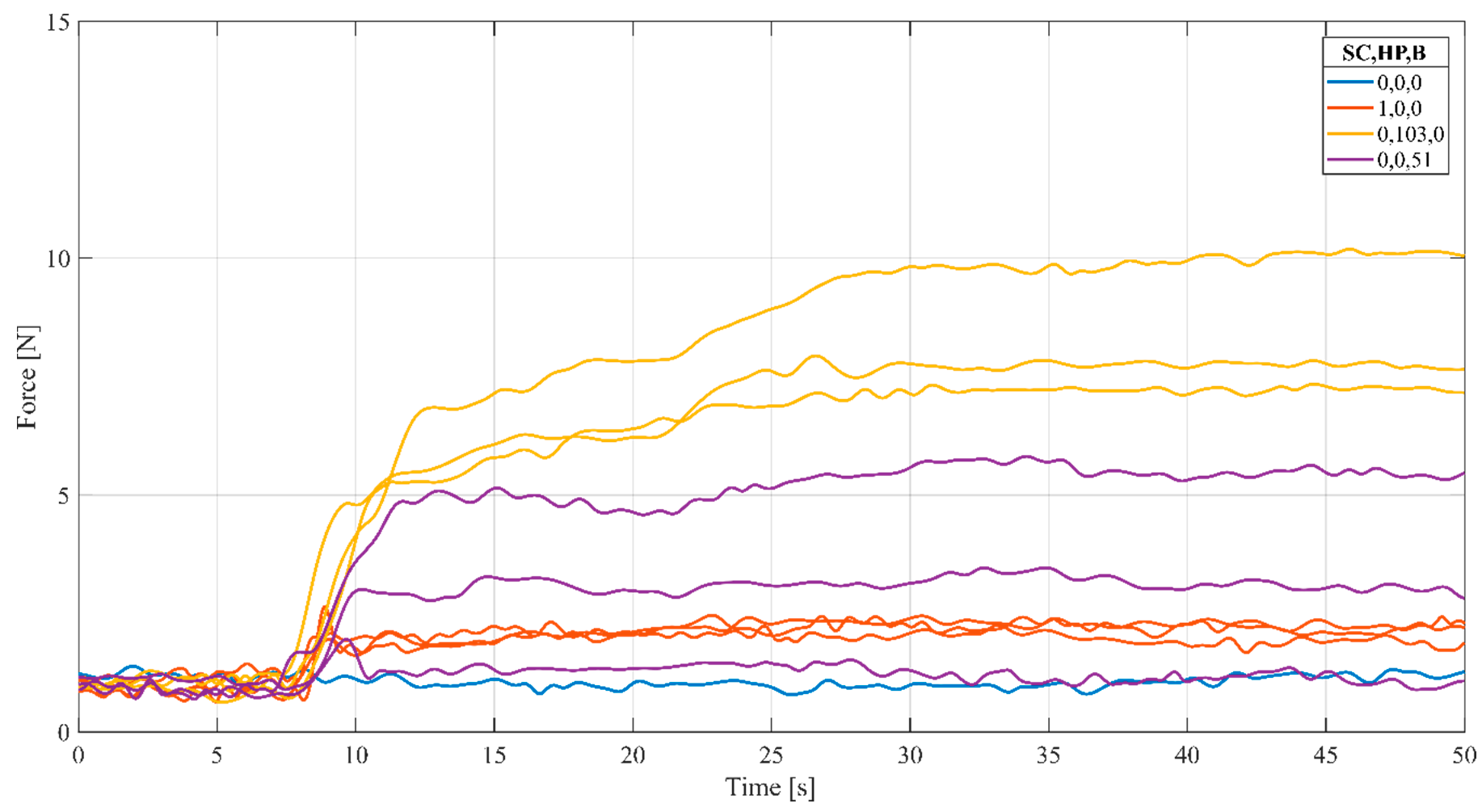
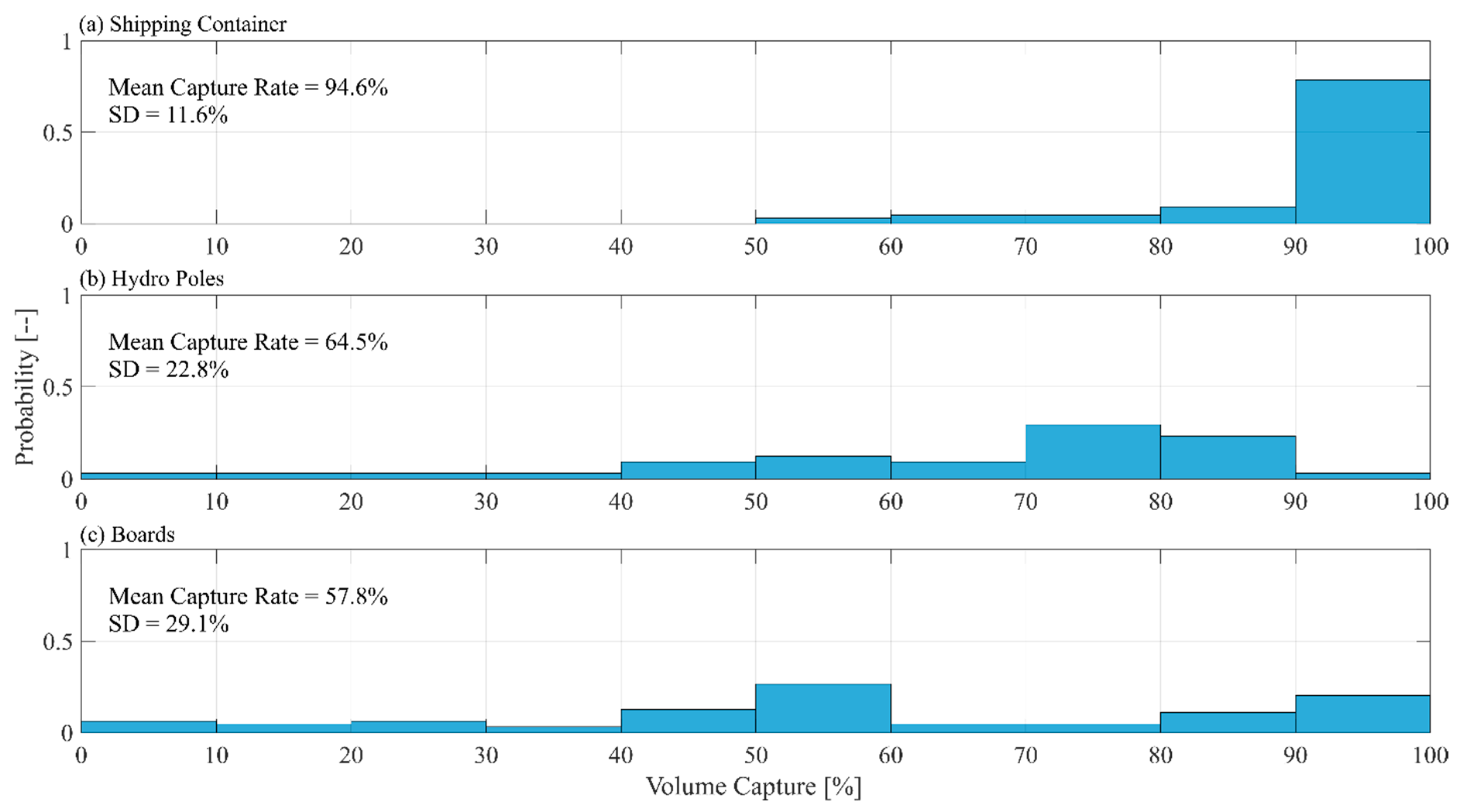

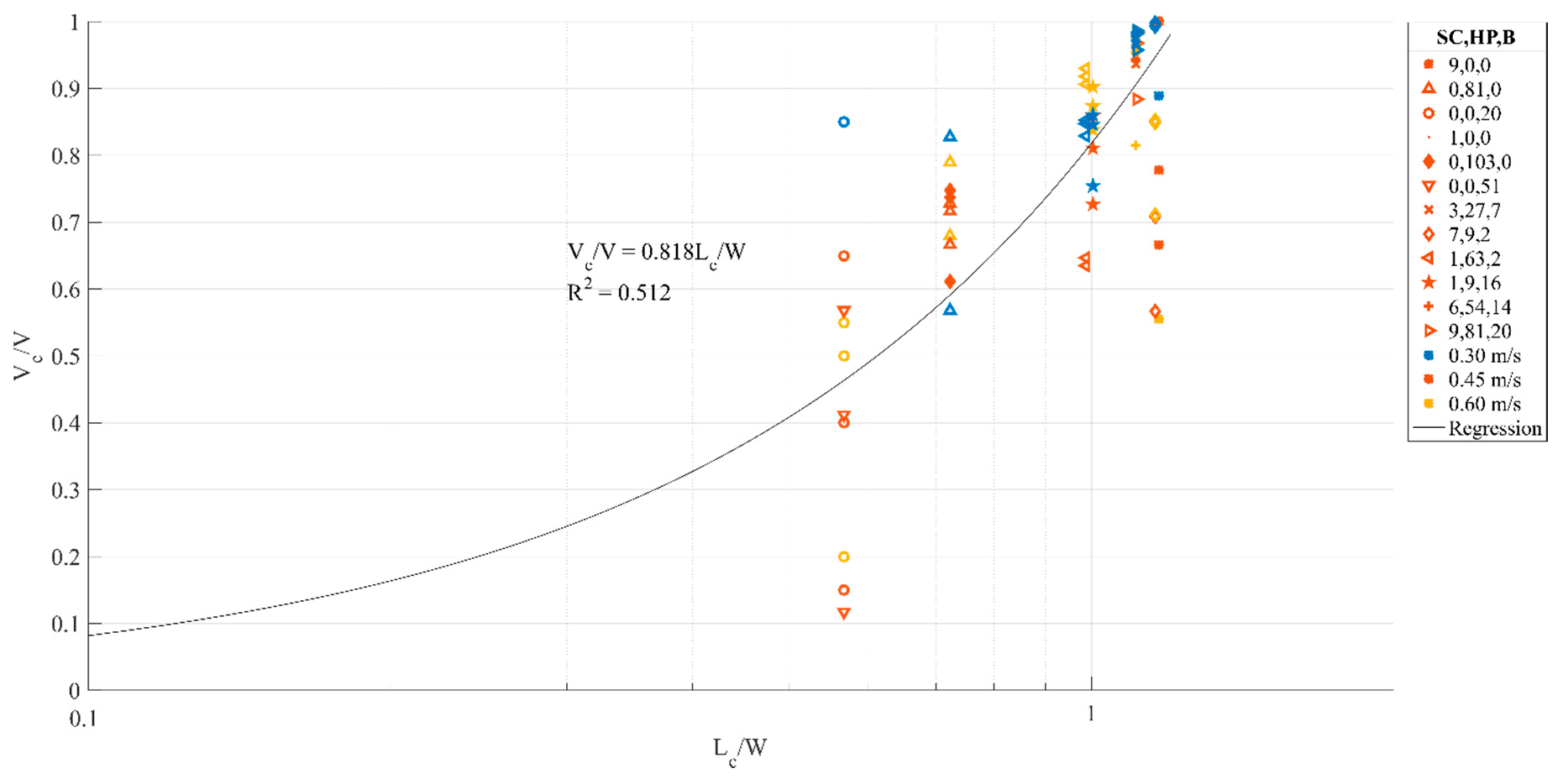
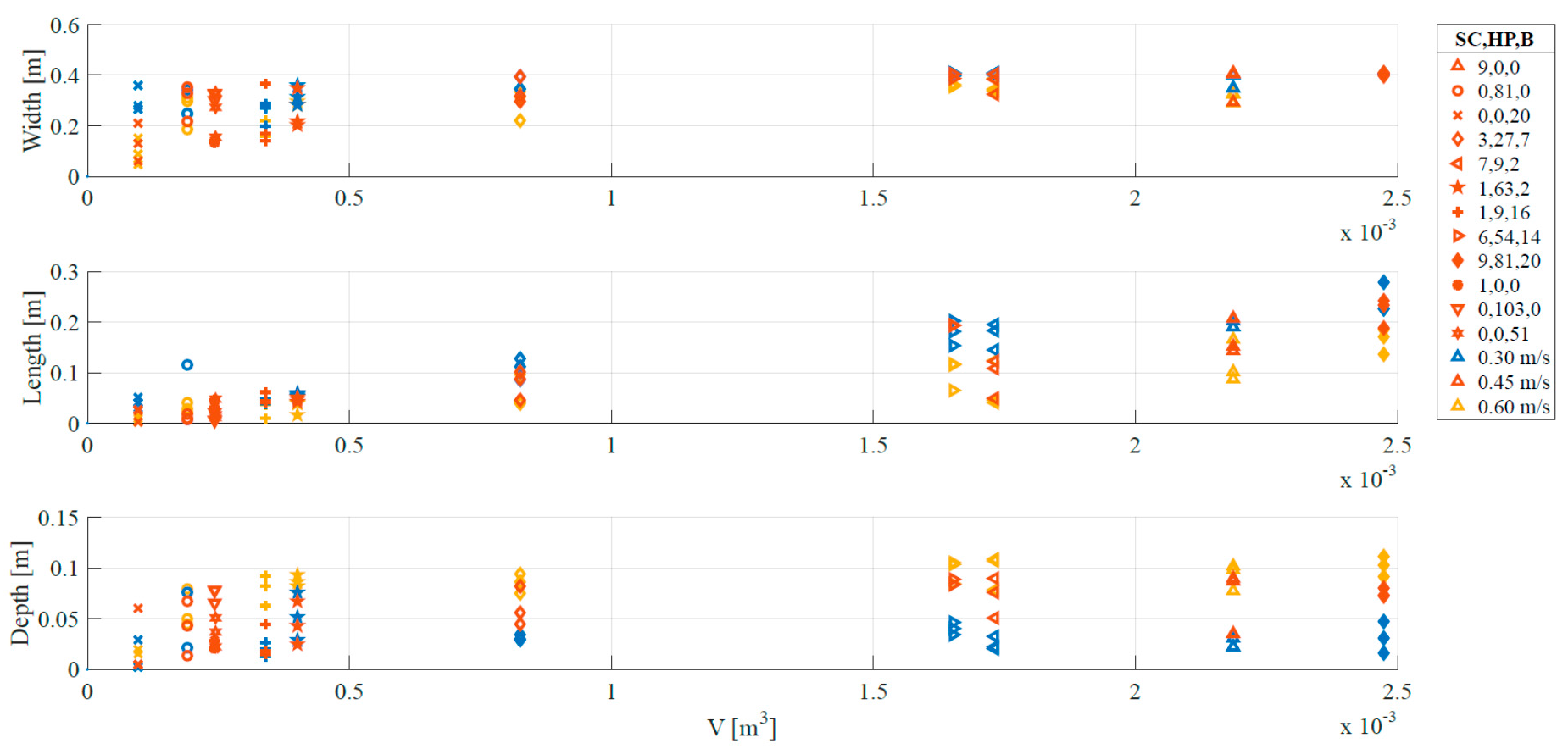


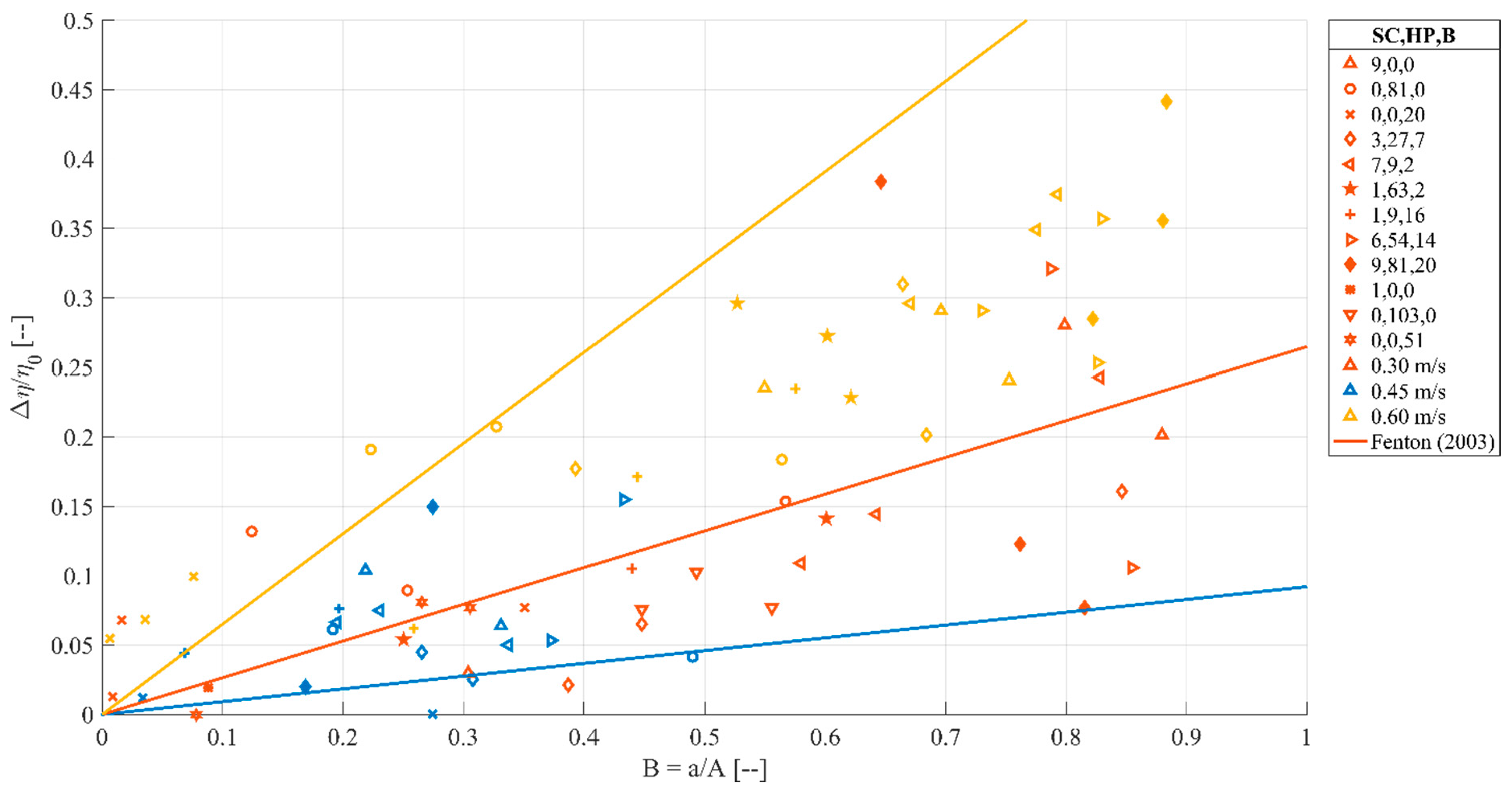

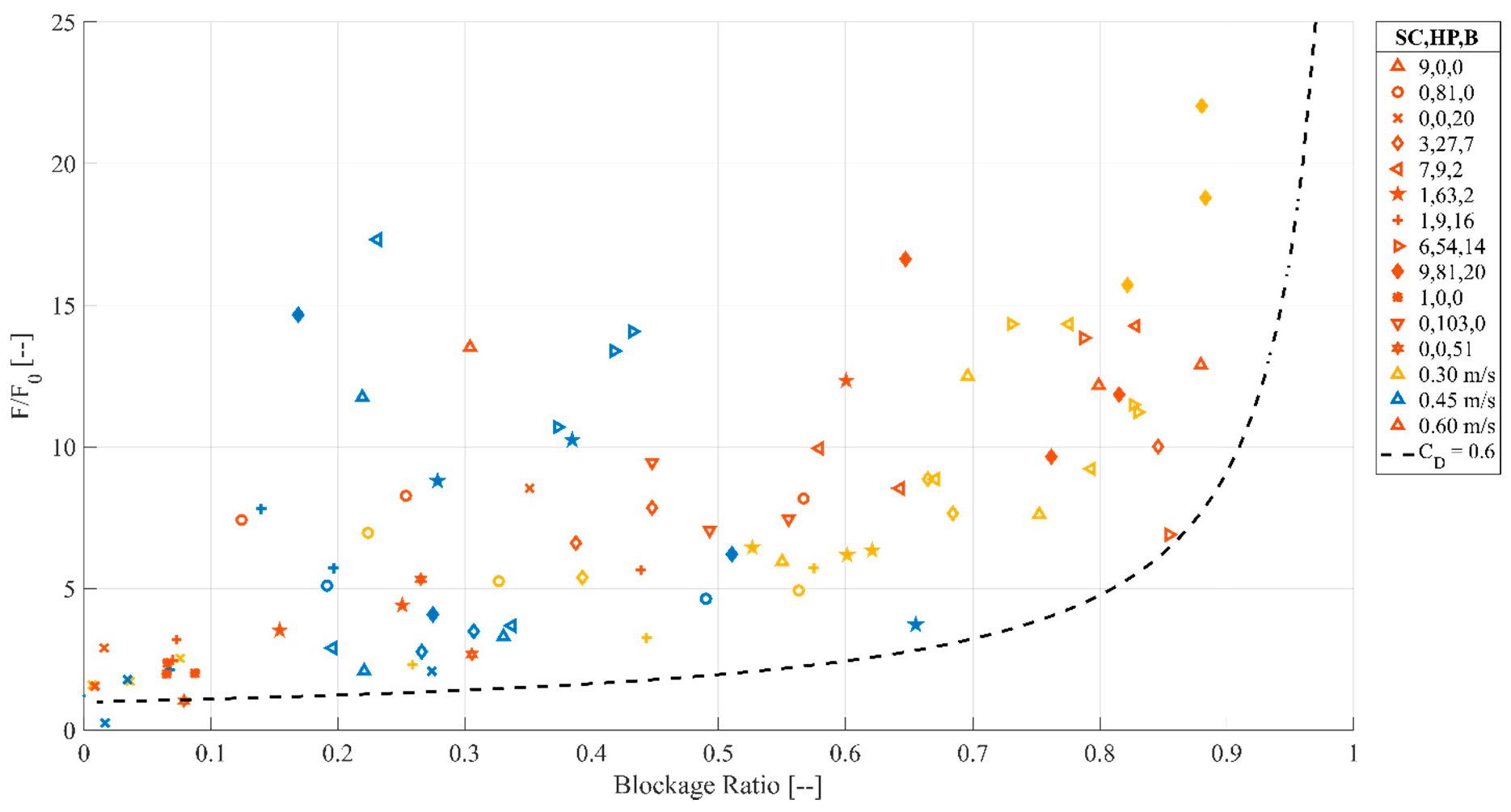

| Instrumentation | Model | Instruments |
|---|---|---|
| Wave Gauge (WG) | KENEK CH-601 | WG1, WG2, WG3 |
| Electro-current Meter (ECM) | KENEK MT2-200 | ECM1, ECM2 |
| Video Camera (VC) | JVC Everio GZ-HM440 | |
| High-Speed Camera (HS) | KATO KOKEN k4 | |
| Load Cell (FT) | SSK LB120-50 | |
| Data Acquisition System (DAQ) | KENEK ADS2016 |
| Debris Properties | Dimensions | Dimensionless Variables | ||||
|---|---|---|---|---|---|---|
| Type of Debris | Length (m) | Width (m) | Height (m) | Characteristic Length (m) | Surface Area-to-Volume Ratio (m−1) | Length (-) |
| Shipping Container (SC) | 0.12 | 0.045 | 0.045 | 0.070 | 105.56 | 1.17 |
| Hydro Pole (HP) | 0.12 | 0.005 | 0.005 | 0.043 | 816.67 | 0.72 |
| Board (B) | 0.06 | 0.04 | 0.002 | 0.034 | 1083.33 | 0.57 |
| Category | Experimental Condition | Water Depth (h) (m) | Flow Velocity (v) (m/s) | (-) | Debris Cases (SC,HP,B) |
|---|---|---|---|---|---|
| 1 | A | 0.10 | 0.60 | 0.60 | 0,0,0 |
| 2 | 9,0,0 | ||||
| 3 | 0,81,0 | ||||
| 4 | 0,0,20 | ||||
| 5 | 3,27,7 | ||||
| 6 | 7,9,2 | ||||
| 7 | 1,63,2 | ||||
| 8 | 1,9,16 | ||||
| 9 | 6,54,14 | ||||
| 10 | 9,81,20 | ||||
| 11 | B | 0.10 | 0.30 | 0.30 | 0,0,0 |
| 12 | 9,0,0 | ||||
| 13 | 0,81,0 | ||||
| 14 | 0,0,20 | ||||
| 15 | 3,27,7 | ||||
| 16 | 7,9,2 | ||||
| 17 | 1,63,2 | ||||
| 18 | 1,9,16 | ||||
| 19 | 6,54,14 | ||||
| 20 | 9,81,20 | ||||
| 21 | C | 0.10 | 0.45 | 0.45 | 0,0,0 |
| 22 | 9,0,0 | ||||
| 23 | 0,81,0 | ||||
| 24 | 0,0,20 | ||||
| 25 | 3,27,7 | ||||
| 26 | 7,9,2 | ||||
| 27 | 1,63,2 | ||||
| 28 | 1,9,16 | ||||
| 29 | 6,54,14 | ||||
| 30 | 9,81,20 | ||||
| 31 | 1,0,0 | ||||
| 32 | 0,103,0 | ||||
| 33 | 0,0,52 |
© 2017 by the authors. Licensee MDPI, Basel, Switzerland. This article is an open access article distributed under the terms and conditions of the Creative Commons Attribution (CC BY) license (http://creativecommons.org/licenses/by/4.0/).
Share and Cite
Stolle, J.; Takabatake, T.; Mikami, T.; Shibayama, T.; Goseberg, N.; Nistor, I.; Petriu, E. Experimental Investigation of Debris-Induced Loading in Tsunami-Like Flood Events. Geosciences 2017, 7, 74. https://doi.org/10.3390/geosciences7030074
Stolle J, Takabatake T, Mikami T, Shibayama T, Goseberg N, Nistor I, Petriu E. Experimental Investigation of Debris-Induced Loading in Tsunami-Like Flood Events. Geosciences. 2017; 7(3):74. https://doi.org/10.3390/geosciences7030074
Chicago/Turabian StyleStolle, Jacob, Tomoyuki Takabatake, Takahito Mikami, Tomoya Shibayama, Nils Goseberg, Ioan Nistor, and Emil Petriu. 2017. "Experimental Investigation of Debris-Induced Loading in Tsunami-Like Flood Events" Geosciences 7, no. 3: 74. https://doi.org/10.3390/geosciences7030074





